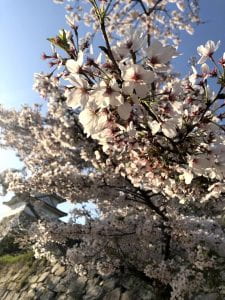Risa is a current LTS MA student.
Hello Risa! Tell us a little bit about yourself and your background.
Hi! My name is Risa Miura and I’m from Japan. When I was in Japan, I worked as an English teacher at cram schools for about 3 years and also worked as a barista for 2 years in Japan and Australia. I love making pour over coffee every morning to experiment with different recipes even though I am a tea person! I also like cooking and baking. Recently I hosted a birthday party for my partner, and I made coffee tiramisu which was my own version of a recipe from one of the cafes I worked at.
It is sometimes hard to believe that I have actually studied in the U.S. again after COVID happened and the experience I had in Tennessee, but I always hoped to come back and study languages and pedagogy from different perspectives. From my former study abroad experience in Tennessee, I witnessed how native English speakers discriminate against those who do not share their privilege of native-level proficiency. This “English First” mentality ignores the purposes of why people learn English in this globalizing world, so I decided to pursue a master’s project in the U.S. to better understand this issue.
What are you working on for your LTS MA project? What inspired you to work on this topic?
I am working on including pragmatics into English classrooms in Japanese high schools and encouraging both teachers and students to use English as a medium of communication in a EFL environment. Since the Japanese national curriculum was revised and began to be adapted in April 2022, many Japanese English teachers face difficulties in teaching those revisions, as they didn’t learn the language in that manner. The speaking proficiency of Japanese learners of English is often brought up because they tend to have an immense gap between production skills and receptive skills. One reason is because Japanese do not have any immediate need to use foreign languages, so it often diminishes learners’ motivation. Second is because English has been taught as a school subject and not as a communicative tool to negotiate the meaning or exchange information in a language class, which is understandable as the main entrance examination for universities only measures reading and listening skills. As the world continues to globalize; however, I believe it is essential for all language speakers to display an attitude to understand each other, especially for one who communicates in L2. In my context, the policies of World Englishes and English as a Lingua Franca are rarely introduced and understood in the classroom and society. Rather, many people mind their Japanese accent or feel inferiority in producing “imperfect” learners’ English. Therefore, in my MA project, I am creating a portfolio that facilitates the use of English as a medium of communication and that better focuses on making themselves understood with WE and ELF in mind.
You have also been teaching Japanese this year at the UO. Can you tell us more about what you are teaching and what this experience has been like for you? Has it been very different from teaching English?
I have been leading a discussion section of first year Japanese students, and this is also my first-year teaching Japanese in a foreign language setting. My job in the classroom is to have students use and experiment with the grammar and vocabulary that they learned previously and to give immediate feedback to encourage them. Outside the class, grading homework and supporting the students during my lab hours are the main tasks. Especially the first term teaching Japanese made me nervous and concerned, but all the students I had and I have now are very nice and hardworking considering its intensiveness. I am often
impressed by them and motivated to be a better language teacher.
Comparing my experience of teaching languages in Japan and the U.S., Japanese classes here have more speaking practice and information exchange among the students while the two languages are taught in foreign language environments. Many English classes in Japan put major focus on developing students’ grammar and vocabulary knowledge and few practice using them for communication. Also, teaching my L1 has entailed many eye-opening moments as I receive teaching materials and questions from the students. It is interesting to see the reasons that learning Japanese is difficult for those who have different linguistic and cultural backgrounds and to observe how language learners of Japanese develop their proficiency.
On a personal note, how has it been to live in Oregon? What do you like about Oregon and what do you miss about Japan?
I like living in Oregon so far! I feel it is rare to see in the U.S. where people can get around everywhere on foot, which was one of the reasons I decided to apply to the UO. It is always nice that I don’t need to ask someone to take me to the closest grocery store, which was actually my previous study abroad experience where otherwise I had to walk on the edge of the car lanes with no sidewalk for 30 minutes!
I miss food in Japan, a Japanese shower room and restroom. For food, not to mention it is hard to find good Japanese food here, it is often expensive. Even when trying to make one by myself, ingredients are either very expensive or unsold in groceries, so it has been a great adventure for me to prepare food every day with challenges. However, I enjoy learning other cuisines, so overall, those challenges help me add new recipes to my cookbook. For shower, especially on cold days here, I miss bathing in the bathtub every day to relax and reflect on many things. Also, it reminds me of how clean and relaxing the shower rooms and restrooms were in Japan.
What is a fun fact about yourself that others may not know yet?
As I mentioned a little bit about my experience as a barista earlier, I did an internship in Australia for only about 6 weeks or so during summer break in my undergraduate university. I enjoyed not only learning about coffee for the first time and Australia’s unique coffee culture, but also it was fascinating to learn and use the Australian and some of the New Zealand English accents from regular customers. After returning to Japan, I decided to learn more about coffee, so I worked part time for about 2 years. During that time, I trained my pallet to appreciate coffee and myself in creating latte art. As a result, I can make all the basic patterns and varieties of a swan, a squirrel, and a seahorse! One of the places I worked at was fortunate enough to be able to work with a World latte art champion and a world brewer’s champion, so I polished my skills with the two legends. As a kid, I earned a token of mastery in Japanese calligraphy, where I developed the dexterity and concentration that may have assisted practicing coffee and latte art. My calligraphy works were exhibited several times and even now I sometimes practice writing to concentrate or just escape from reality, which I feel it’s useful for teaching and learning with my students in Japanese classes.



